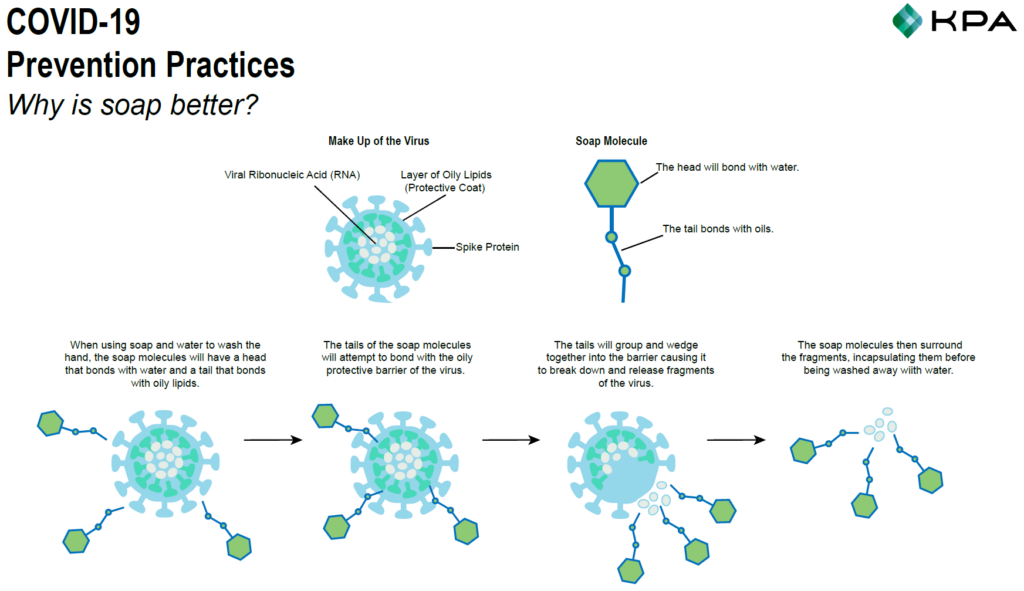How to Prevent Coronavirus Infection in the Workplace: Best Practices
The world is fighting a war against an invisible enemy. As of this writing, there are over 300,000 confirmed cases of COVID-19, commonly known as the coronavirus. Entire cities, states, and countries are under lockdown. The global economy is plummeting. And authorities such as the World Health Organization and the US Surgeon General say the situation is going to get worse.
It’s a deeply terrifying and uncertain time, especially for anyone without the option of working from home. Employees and decision-makers throughout organizations and industries are concerned about their health as well as that of their co-workers, families, and communities.
Don’t Panic
We’re here to help you get through this. Although there’s currently no vaccine or cure for COVID-19, there are several ways to minimize infection and keep your people (and yourself) healthy and safe.
As for safety professionals, our job here at KPA is to evaluate and manage hazards for our clients. With decades of experience in our field, our team is well-equipped to help businesses navigate this crisis. The coronavirus may be novel, but infectious diseases are nothing new. Many of the same methods organizations use to control other infections can effectively help with how to prevent Coronavirus and stop the person to person spread.
COVID-19 Prevention Requires the Right System
To protect people from any hazard, including the coronavirus, an organization must implement a hierarchy of controls, which structures protective measures into 5 stages:
1. Elimination
2. Substitution
3. Engineering Controls
4. Administrative Controls
5. Personal Protective Equipment
These stages can be thought of as lines of defense, with #1 (Elimination) being the first and most effective line of defense, and #5 (PPE) being the last resort. Here’s how to put a hierarchy of controls into action in your workplace:
Elimination: Physically Remove the Hazard
This is the first and most powerful option. Unfortunately, in this case, it’s also the most challenging. Once a virus has entered an environment, you can’t physically remove it—not conclusively or permanently. Instead, you have to remove the people. The only way to eliminate your workforce’s exposure to the virus is to temporarily close your business. No work means no chance for workers to transmit COVID-19 to each other.
Substitution: Replace the Hazard
Given that few organizations can afford to close down indefinitely, many businesses are embracing the second most powerful form of control: substitution. Again, you can’t replace a virus, but you can replace the workplace with another environment—or rather a network of isolated environments. In the context of the coronavirus pandemic, substitution means having employees work from home. No shared environment, no possibility of workplace transmission.
Engineering Controls: Isolate People from the Hazard
In the safety field, engineering controls frequently take the form of machines and structures—e.g. fences, lifts, restraints, and pullback devices. With a disease like COVID-19, we need to think differently. Obviously, there’s no way to build a fence around a virus.
Instead of just isolating employees from hazardous areas, your organization needs to consider ways of isolating employees from each other. Workers should be separated into discrete work areas such as cubicles or offices that are situated far apart from one another. Also be sure to remove any community amenities such as coffee stations, snack plates, community sitting areas, breakrooms, and so on.
At the same time, you’ll need to keep your customers far apart or, better yet, restrict them from entering your physical location. If customers must enter your business, limit their proximity to each other, as well as to employees, especially any receptionists. You may want to consider erecting a temporary partition at your front desk.
Administrative Controls: Change the Way People Work
This is perhaps the most practical form of coronavirus prevention for most facilities. With administrative controls, your organization keeps your people safe through policy-level behavioral interventions.
Social distancing is one form of administrative control. The Centers for Disease Control and Prevention recommends that people maintain at least 6 feet of distance from one another at all times. This means no touching of any kind—no handshakes, no hugs, no high-fives.
One way to enforce distance is to require employees to leave at least one seat between them during meetings and other activities in which multiple people are located in one room. Where and when possible, you can also limit the number of people who can occupy a space.
Your organization should also institute mandatory hand-washing times. Employees within any shared physical environment should wash their hands every 30 minutes or on another frequent basis. You may want to announce hand-washing times over your speaker system or remind people via email or text. No matter what, employees should wash their hands for at least 20 seconds every time.
Hands aren’t the only things that need cleaning. Be sure to disinfect common surfaces such as desks, door handles, stair handrails, elevator buttons, and light switches. Wipe things down often. Studies indicate that COVID-19 may be able to survive on inorganic surfaces for up to 72 hours.
Finally, eliminate any sharing practices as well. Employees should not be sharing phones or keys. Any shared vehicles should be disinfected between uses. Disable touch screens or restrict their use wherever possible, and wipe them down regularly.
What You Need to Know About Sanitation Products and Cleaning Supplies
Cleanliness and personal hygiene are essential for minimizing the spread of COVID-19. Place sanitation products such as gloves and soap in easily accessible areas for employees and customers. Again, make sure people are washing their hands and disinfecting surfaces frequently.
Check out KPA’s quiz: Should You Clean or Disinfect That?
Which disinfectants are effective against the coronavirus?
The CDC has posted the following (emphasis added): “For disinfection, diluted household bleach solutions, alcohol solutions with at least 70% alcohol, and most common EPA-registered household disinfectants should be effective.” For the EPA’s list of registered disinfectants, click here.
Which is better: soap or hand sanitizer?
According to the CDC, the combination of soap and water is better than hand sanitizer. There’s science behind this. The chemical structure of soap dissolved in water, combined with 20 seconds of scrubbing, breaks down the molecular components of the coronavirus. Hand sanitizer, by contrast, “acts to disrupt RNA molecules in the virus, preventing viral replication.”
In other words, hand sanitizer may kill the virus but it doesn’t physically remove particles as well as washing with soap would. That also means that hand sanitizer is less effective when hands are covered in grease and dirt. In fact, other particles can act as a barrier, preventing the sanitizer from reaching viral particles. (Beyond our current pandemic concerns, keep in mind that sanitizers may also fail to remove harmful chemicals such as pesticides and heavy metals from the skin.)
For more details, see the chart below:

What kind of soap is best?
Practically any type of hand soap will work. You don’t specifically need antibacterial soap, as COVID-19 is a virus, not bacteria.
Bar soap is just as effective as liquid soap. You don’t need a pump dispenser as long as you’re washing your hands with soap and water for at least 20 seconds.
Water temperature doesn’t matter. Hot water will provide a better lather, but hotter does not mean more effective. Studies show that the temperature of water has no impact on germ removal. You don’t need to scald yourself.
Do you really need to wash your hands for 20 seconds?
Yes. Make sure to scrub all parts of both hands as well—front, back, under the thumbs and fingernails, and in the webbing between fingers. Many people don’t realize how long 20 seconds actually is. You may need to count to 20 (“1 Mississippi, 2 Mississippi,” etc.) or sing a 20-second tune. If you’re tired of “Happy Birthday,” how about the chorus of “Jolene” or the Jeopardy theme song? One of our favorites, per NPR: the chorus of Queen’s “We Will Rock You” 3 times, but with “wash you”—We will, we will wash you.
We’ll continue to offer guidance on this topic as the current situation progresses, so be sure to subscribe to our blog.
For more resources about COVID-19/the coronavirus, visit KPA’s COVID-19 Resource Center.
Get Started with KPA
Make Compliance Easy. Prioritize Workforce Safety. Return to Productivity. COVID-19 Safety Program.
Want to learn more about KPA’s environment, health, and safety programs? Give us a call at 866-356-1735, or send us an email at info@kpa.io.
Ready to see our solution for yourself? Click here to request a demo.

